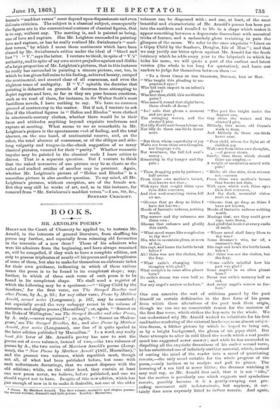LETTER TO THE EDITOR.
MR. LEIGHTON'S " HELIOS AND RHODOS."
(TO TRH EDITOR OF TRH "SPECTATOR']
SI11,—Your critic "V.," whose criticisms always carry weight, seems to me very severe upon Mr. Leighton's "Helios and Rhodos." He has a right to be so, but if I am not utterly mistaken, his verdict in this case is only the more dangerous to the progress of English Art because it appears so plausible. "Mr. Leighton Helios and Rhodos," "V." says, "is in close relationship with Mr. Swinburne's maddest verses." Now, the picture in question represents the meeting of the youthful God of the Sun descending at sunset from his chariot aloft to meet the beloved Rhodos, who springsfrom the sea into his embrace in a perfect trance and rapture of love; I do not wish to enter into any formal controversy with "
bat, such being the subject, it is clear that the question whether or not the picture really is in "close relationship" to Mr. Swiu
burne's "maddest verses" must depend upon dispassionate and even delicate criticism. The subject is a classical subject, consequently the figures are in the conventional costume of classical figures, that is to say, without any. The meeting is, and is painted as being, one of love and rapture. Has Mr. Leighton succeeded in painting love and rapture, or has he really realized Mr. Swinburne's "maddest verses," by which I mean those sentiments which have been classed by Mr. Swinburne's critics under the ideal of "blood and lust " ? "V." says the latter. I venture to think, in spite of" V.'s" authority, and in spite of my own secret prejudice against and dislike of a large proportion of Mr. Leighton's pictures, that in this instance he really has succeeded in painting a sincere picture, one, too, in which he has given full reins to his feeling, achieved beauty, escaped the sentimental, and steered clear of all coarseness, and even the slightest trace of ambiguity. If "V." upholds the doctrine that painting is debarred on grounds of decorum from attempting to depict rapture and love, so far as they are pure human emotions, such as we read of them, for instance, in Sir Walter Scott's most fastidious novels, I have nothing to say. We have no common ground of controversy in the matter. But if not, I venture to ask him if the identical figures in " Helios and Rhodos" were clothed in nineteenth-century clothes, whether there would be in their faces and attitudes anything beyond exquisite tenderness and rapture at meeting. What seems to me so remarkable in Mr. Leighton's picture is the spontaneous rush of feeling, and the total absence, on the one hand, of sentimental reserve, and, on the other, the total absence of coarseness, or of the oblique and sidelong vulgarity and tongue-in-the-cheek suggestion of so many classical pictures, vaunted for their "purity." Whether romantic impulse may be painted in the classical nude I leave critics to discuss. That is a separate question. But I venture to think that the naked unreserve of one picture may be as chaste as the veiled and studied artifice of another may be prurient. Again, whether Mr. Leighton's picture of "Helios and Rhodos" is a masculine picture is also another question. To my mind, all Mr. Leighton's pictures, without exception, are of the female sex. But they may still be works of art, and, as in this instance, far removed from "Mr. Swinburne's maddest verses."—I am, Sir, &c.,
BERNARD CEACROFT.































 Previous page
Previous page